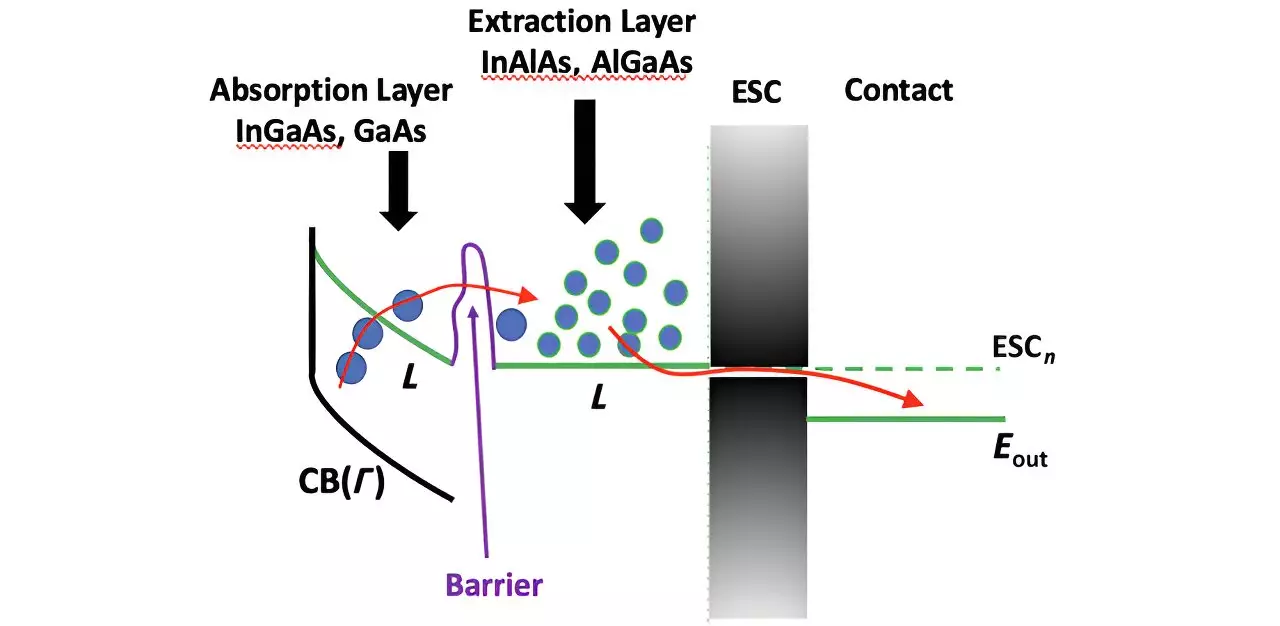Hot carrier solar cells have captivated the attention of researchers since their inception decades ago. Unlike conventional solar cells, which adhere to the Shockley-Queisser limit — a theoretical cap on efficiency for single-junction systems — hot carrier cells are thought to bridge this gap and push the boundaries of solar technology. By effectively capturing and utilizing hot electrons, these solar cells offer a tantalizing possibility: significantly enhanced energy conversion rates, crucial in a world demanding more efficient solar energy solutions. However, despite their potential, substantial barriers remain, complicating the pathway to their practical application.
Several studies have illuminated the obstacles faced by hot carrier solar cells, with a primary focus on the swift extraction of hot electrons across interfaces in heterostructures. The crux of the issue lies in managing the transition of hot electrons from their initial energetic states to utility without loss. Recent advances in this area have seen researchers investigate the satellite valleys within the conduction band of materials. These valleys temporarily house hot electrons, creating a potential opportunity for efficient extraction. Yet, experiments reveal a significant hindrance: a parasitic barrier interposed between the absorber and extraction layers within the heterostructure.
When the electronic energy bands of these materials are misaligned, the transfer of electrons becomes intricate, necessitating tunneling through this barrier. Tunneling can be a complex process influenced by the bands’ intricate structures, necessitating a nuanced understanding of the physics at play in these solar cells.
Revolutionizing Understanding through Research
A pivotal study recently published in the Journal of Photonics for Energy employed an empirical pseudopotential method to scrutinize the behavior of hot carrier extraction across material interfaces. By calculating energy bands in momentum space and juxtaposing them with empirical data at critical points, the research has begun to shed light on the nuanced processes governing electron tunneling. This new understanding is vital for developing more effective hot carrier solar cells and may indeed hold the key to overcoming the efficiency limitations hampering existing solar technologies.
In particular, the research highlighted a critical factor: the tunneling coefficient — a metric that quantifies how easily electrons can traverse the energetic barrier — displayed significant variability based on the materials in use. For instance, in indium-aluminum-arsenide (InAlAs) and indium-gallium-arsenide (InGaAs) structures, this coefficient was found to be exponentially large due to the inherent mismatch between the energy bands of these two materials. Furthermore, even minimal roughness at the atomic interface proved to exacerbate this issue, leading to poor performance in experimental device setups.
Intriguingly, when researchers shifted their focus to aluminum-gallium-arsenide (AlGaAs) paired with gallium-arsenide (GaAs), the situation showed remarkable improvement. Here, the aluminum composition in the barrier contributed to a degeneracy of lower energy satellite valleys, benefiting the alignment of energy bands. This precision allows for better control over the material synthesis, overcoming poorer performance exhibited by other materials. The study even indicated that the tunneling coefficients for electron transfer between AlGaAs and GaAs could range significantly, reflecting compositions that optimize this interaction.
These findings are not merely incremental; they suggest a radical shift in how solar cell technology could approach energy conversion efficiency. The potential to utilize valley photovoltaics and surpass the conventional single bandgap limits conjures a vision for a future where solar cells could capture and utilize nearly every photon, significantly improving their viability and appeal in a rapidly evolving energy landscape.
The ongoing research into hot carrier solar cells presents an exciting frontier in renewable energy. By meticulously addressing the challenges of electron transfer and optimizing material properties, such cells may unlock a level of efficiency previously thought unattainable. As research progresses, the dream of harnessing solar energy in a sustainably efficient manner moves closer to reality. By investing in and understanding these cutting-edge technologies, we stand on the precipice of a new era in solar energy, potentially reshaping the global energy landscape for generations to come.

